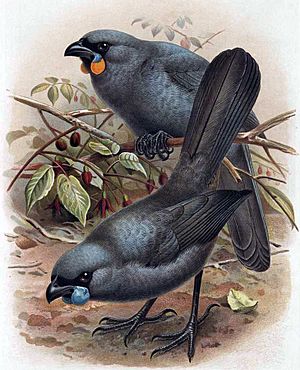South Island kōkako facts for kids
Quick facts for kids South Island kōkako |
|
|---|---|
 |
|
| North Island kōkako (front) and South Island kōkako (rear) | |
| Conservation status | |
| Scientific classification | |
| Genus: |
Callaeas
|
| Species: |
cinerea
|
 |
|
| Estimated maximum distribution Estimated distribution around time of European settlement | |
| Synonyms | |
|
C. cinerea cinerea |
|
The South Island kōkako (Callaeas cinereus) is a special forest bird that might be extinct. It lived only on the South Island of New Zealand. This bird is related to the North Island kōkako.
The South Island kōkako had bright orange wattles (fleshy flaps of skin) on its face. It only had a small blue patch near the bottom of these wattles. People sometimes called it the orange-wattled crow, even though it was not a crow. The last time someone officially saw this bird was in 2007. This was the first accepted sighting since 1967. There have been other reports, but they were not confirmed.
Contents
What is the South Island Kōkako?
The kōkako was first described in 1788 by a German scientist named Johann Friedrich Gmelin. He named it Glaucopis cinerea. The word cinerea comes from Latin and means "grey".
For a while, the North Island and South Island kōkako were thought to be the same species, just different types. But since 2001, scientists have agreed they are two different species. The North Island bird is now called C. wilsoni. Genetic tests have shown that they are indeed different.
What Did the South Island Kōkako Look Like?

The South Island kōkako was a slate-grey bird. It had long legs and a small black mask around its eyes. One explorer, Andreas Reischek, thought its feathers were a bit lighter than the North Island kōkako.
Its wattles were a clear orange color with a dark blue base. Young kōkako birds had much lighter wattles. This bird seemed to spend more time on the ground than the North Island kōkako. However, it was also a better flyer.
Kōkako birds have special calls that sound like an organ or a flute. They often sing together in duets. Early explorer Charlie Douglas described the South Island kōkako's call. He said, "Their notes are very few, but the sweetest and most mellow toned I ever heard a bird produce." The eggs of the South Island kōkako were also bigger than those of the North Island species.
Where Did the South Island Kōkako Live?
When Europeans first arrived in New Zealand, South Island kōkako lived in many places. They were found on the West Coast, from northwest Nelson down to Fiordland. They also lived on Stewart Island, Banks Peninsula, and in the Catlins.
Old bones found in the ground show that they used to live all over the South Island. But early Polynesians burned forests, which made the birds disappear from dry eastern lowland forests. Later, European settlers brought new animals like stoats and rats. These animals hunted the kōkako. Settlers also cleared more forests. These things made the kōkako numbers drop even more. By 1900, the bird was rare. By 1960, it had almost vanished. The South Island kōkako might have been more at risk because it often looked for food and built nests close to the ground.
Is the South Island Kōkako Extinct?
In 2007, New Zealand's Department of Conservation officially said the South Island kōkako was extinct. This was because it had been 40 years since the last confirmed sighting in 1967 at Mt Aspiring.
However, in November 2013, something changed. The Ornithological Society of New Zealand accepted a sighting from 2007 as real. Two people reported seeing the bird near Reefton. Because of this, the bird's status changed from "extinct" to "data deficient." This means there isn't enough information to say for sure if it's extinct or not. Eleven other sightings from 1990 to 2008 were only considered "possible" or "probable."
In 1995, someone found a feather they thought was from a kōkako. But scientists at the National Museum checked it. They found out it was actually from a blackbird. People still report seeing South Island kōkako or hearing their calls. But there is no recent confirmed evidence like bones, feathers, droppings, videos, or photos.
The IUCN Red List, which tracks endangered species worldwide, lists the South Island kōkako as "Critically Endangered (Possibly Extinct)" as of 2016. The most recent unconfirmed sighting was in November 2018. This was on the Heaphy Track in Kahurangi National Park.
See also
 In Spanish: Kokako para niños
In Spanish: Kokako para niños


